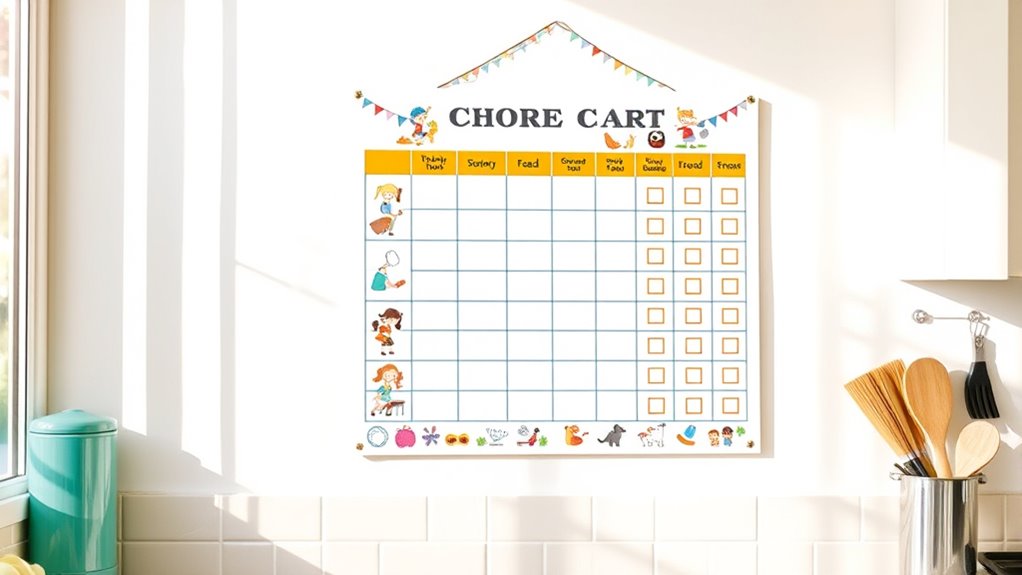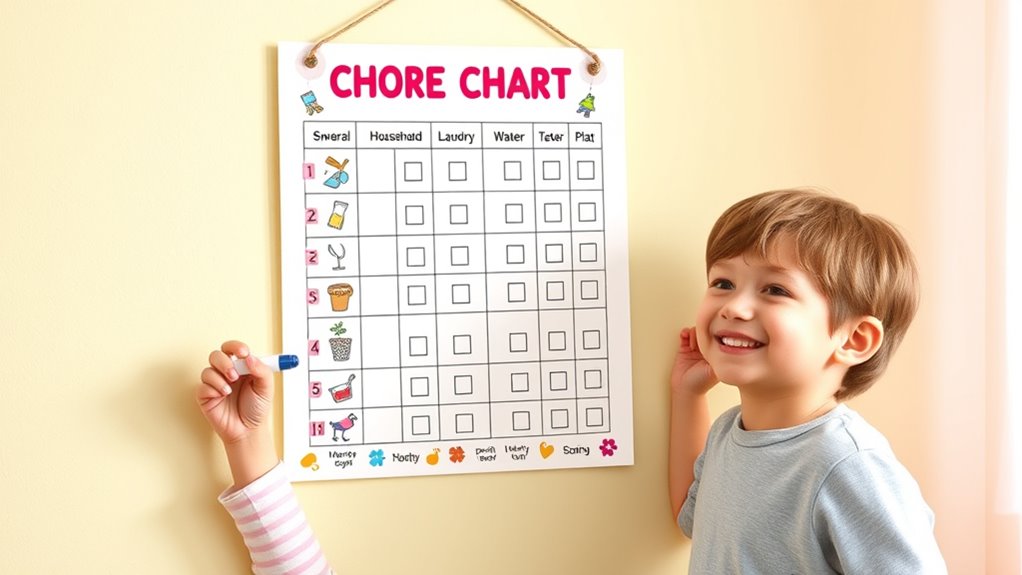To create a printable chore chart that excites kids to help, make it colorful, fun, and easy to use. Use stickers, stars, or points as rewards to motivate your children and track their progress visually. Assign age-appropriate tasks and place the chart somewhere visible to encourage consistency. Celebrating milestones and offering small privileges can boost their enthusiasm. Keep these tips in mind, and you’ll discover how to turn chores into a positive, engaging routine.
Key Takeaways
- Use colorful visuals, stickers, and rewards to make the chart engaging and motivating for kids.
- Assign age-appropriate, fun chores to increase kids’ enthusiasm and sense of achievement.
- Place the chart where kids can easily see it to reinforce daily routines and responsibilities.
- Incorporate a reward system like stars or points to incentivize consistent participation.
- Celebrate milestones and progress to boost children’s pride and encourage ongoing help around the house.

Are you tired of reminding your family about daily chores? It can feel like a constant battle, but implementing a printable chore chart can change that. The key to making it work lies in setting up a reward system and assigning age-appropriate tasks. When kids see tangible rewards and clear expectations, they’re more likely to participate willingly and even look forward to helping out around the house.
Start by creating a reward system that motivates your children. This doesn’t have to be complicated—stickers, stars, or points they can exchange for small treats or privileges work well. The idea is to reinforce positive behavior without making chores feel like a punishment. When kids earn rewards for completing their chores, they associate helping around the house with something enjoyable. Be consistent with the rewards, and make sure to praise their efforts along the way. This boosts their confidence and encourages them to stay committed.
Create simple reward systems like stickers or stars to motivate kids and reinforce positive chores.
Next, focus on assigning age-appropriate tasks. A toddler can help put away their toys, while an older child might handle more involved chores like vacuuming or laundry. The printable chore chart makes it easy to outline these tasks clearly. When children see what’s expected of them on the chart, they understand their responsibilities and can take ownership of their chores. It’s important that each task matches their developmental level so they don’t feel overwhelmed or bored. Plus, involving kids in selecting their chores can give them a sense of autonomy, making them more enthusiastic to participate.
Consistency is essential. Keep the printable chore chart in a visible spot, like the fridge or a family command center, so everyone knows what’s on the agenda each day. Make it a routine—review the chart together, check off completed tasks, and celebrate achievements. Over time, this structure helps children develop good habits and a sense of responsibility. And when they see their progress, especially with the reward system in place, they feel accomplished and motivated to keep helping.
Frequently Asked Questions
How Can I Customize the Chore Chart for Different Ages?
To customize a chore chart for different ages, focus on age-appropriate tasks that match your kids’ abilities. Use customization tips like assigning simpler chores for younger children and more responsibility for older ones. Incorporate visuals or color codes to make it engaging and easy to understand. Adjust the chart regularly to keep it relevant, encouraging each child’s independence and sense of achievement while making chores manageable and fun.
What Materials Are Best for Printing and Durability?
Think of your chore chart as a sturdy ship sailing smoothly—using high-quality printable paper guarantees it doesn’t sink under daily use. For lasting durability, opt for laminated materials, turning your chart into a resilient treasure that withstands spills and tears. Laminated durability keeps your chart looking fresh, while printable paper provides a crisp, clear surface. Together, they create a dependable tool that keeps your kids motivated and engaged every day.
How Do I Motivate Reluctant Children to Complete Chores?
To motivate reluctant children, try implementing rewards systems that recognize their efforts and progress. Make chores fun by involving them in choosing tasks or customizing the chore chart. Show consistent parental involvement, offering praise and encouragement to boost their confidence. When kids feel appreciated and see tangible rewards, they’re more likely to complete chores willingly. Keep expectations clear, and celebrate small wins to foster a positive attitude toward helping around the house.
Can the Chart Be Adapted for Daily and Weekly Tasks?
You can definitely adapt your chart for daily and weekly tasks by incorporating reward systems and visual cues. Use different colors or icons to distinguish tasks, making it easy for kids to see what’s expected each day or week. This approach creates a clear rhythm, helping kids stay engaged. By customizing the chart, you turn chores into a fun, organized routine that motivates kids to participate consistently.
Are There Digital Versions of the Printable Chore Chart?
Yes, there are digital versions of chore chart apps that can replace printable charts. You can find apps designed to make chores fun and easy to manage, allowing you to track daily and weekly tasks electronically. These digital chore chart apps often include customizable features and reminders, making it simple for kids to stay motivated and organized. Switching to digital versions can streamline chore management for your family.
Conclusion
Creating a printable chore chart isn’t just about organizing tasks—it’s about inspiring responsibility and positive habits. When kids feel motivated and involved, they’re more likely to develop a sense of ownership and pride in their chores. Remarkably, some studies suggest that visual reminders like charts can reinforce behavioral changes more effectively than verbal instructions alone. So, by making chores fun and accessible, you’re not just getting help around the house—you’re nurturing lifelong skills that benefit everyone.










